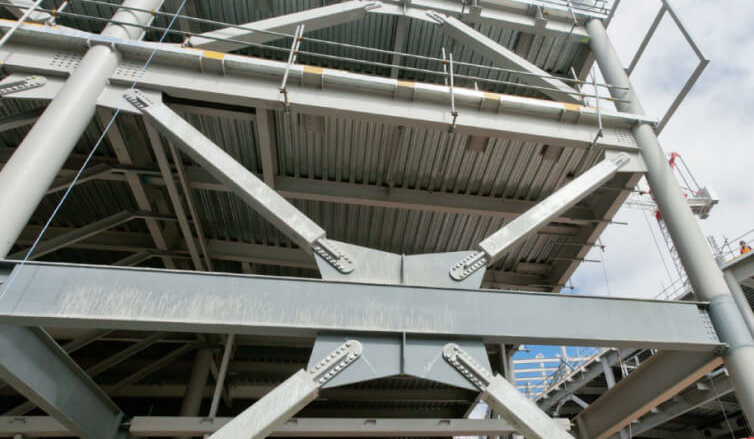The concept of ductile design for anchor bolts revolves around the idea that the failure of an anchorage system should be controlled by the yielding of the anchor, reinforcement, or attachment, rather than by brittle failure of the concrete. This approach results in significant deformation, load redistribution, and energy absorption before the sudden collapse of the system due to brittle failure of the concrete. When anchor bolts fail, they can do so either by pullout of the concrete cone (brittle failure) or by tensile failure of the anchor itself (ductile failure). Brittle failures occur abruptly and without warning, potentially leading to catastrophic incidents, while ductile failures allow the steel to yield gradually, elongate, and absorb a considerable amount of energy, often preventing the structure from collapsing. Consequently, when a structure is designed based on ductility or energy absorption, specific mechanisms for ductility should be incorporated. This is particularly crucial in seismic applications to prevent brittle failures and ensure the safety and resilience of the structure. Incorporating ductile design principles for anchor bolts in accordance with ACI 318 can help achieve this goal.
Anchor bolts must be designed to be governed by the tensile or shear strength of the steel, and the steel must be ductile. If this guideline cannot be followed, the attachment connected by the anchor to the structure must be designed so that it undergoes ductile yielding at a load level no greater than 75 percent of the minimum anchor design strength. The ductility of an anchor system is critical in seismic design, and it is defined as the ability to exhibit a meaningful degree of deformation before failure occurs.
Where we are required to use Ductile Design ?
Anchors designed to resist critical loads, where magnitudes cannot be precisely quantified (e.g., where design is based upon energy absorption), shall be designed using the requirements for ductile design. Examples are anchors in areas of intermediate or high seismicity and anchors used for blast load resistance.
The Main Requirements for Ductile Design
To achieve ductile design, the anchoring capacity of the concrete must exceed that of the anchor in tension, shear, or a combination of both. This strength requirement is independent of the applied loads. If it can be demonstrated that failure due to tensile loads will occur before failure due to shear loads, then the anchor only needs to be ductile for tensile loads.
The first step is to select the anchor size considering only the steel failure modes, using 0.75φNsa and 0.75φVsa. Additionally, ensure that the chosen steel is ductile. These calculations must be done manually, using Appendix D of ACI 318.
The second step in achieving ductile design for anchor bolts is to ensure that the concrete pullout capacities, including concrete breakout strength in tension, pullout strength of anchor in tension, and concrete side-face blowout strength, are greater than the tensile steel capacity of the anchor.
The third step is to ensure that the concrete shear capacities (concrete breakout strength in shear and concrete pryout strength in shear) are greater than the steel shear capacity of the anchor.
Alternatively, the attachment to the structure connected by the anchor to the foundation may be designed to undergo ductile yielding at a load level no greater than 75 percent of the minimum anchor design strength.
If the previously mentioned requirements cannot be met, the concrete capacity can be increased to achieve a ductile design using the following methods:
- Increasing concrete strength
- Increasing embedment depth
- Increasing edge distance (for near edge cases)
- Increasing anchor spacing (for closely spaced anchor groups)
In situations where space is limited, such as anchors embedded in pedestals, the above methods may not be practical. For these cases, reinforcing bars can be placed close to the anchor to transfer the load.
To increase concrete shear capacity, the following methods can be employed:
- Increasing concrete strength
- Increasing edge distance (for near edge cases)
- Increasing anchor spacing (for closely spaced anchor groups)
If the preceding methods are impractical due to space limitations, reinforcing hairpins looped around the anchors can be designed to carry the entire shear. If this method is used, do not consider any contribution from concrete shear strength. Another alternative is the use of a shear lug. If this alternative is chosen, either the following options a or b must be adhered to:
a. The shear lug needs to be designed to undergo ductile yielding before failure of the concrete.
b. The attachment that the shear lug connects to must undergo ductile yielding at a load level no greater than 75 percent of the minimum shear lug design strength.
- Latest Posts by Behnam Heydari
-
Navigating Interdisciplinary Challenges in Petrochemical Facilities
- -
Types of Rigid Pipe Support
- -
What is the redundancy factor based on ASCE 7?
- All Posts


